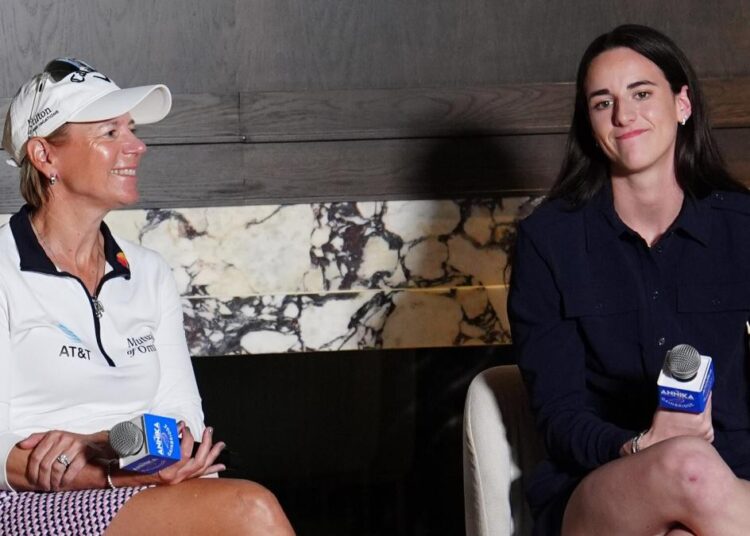When Annika Sorenstam was 22, she was wrapping up a successful college career at Arizona and turning pro, just beginning what would be a historic career that would end with 97 professional wins and 10 LPGA majors.
Fast forward 32 years and Sorenstam is seated next to a 22-year-old Caitlin Clark at The Annika Women’s Leadership Summit – two women who are very different but also share similarities as some of the best athletes in the world and trailblazers for women’s sports.
In 2024 alone, Clark, who is currently one of the most popular athletes in America, led Iowa to a second straight NCAA runner-up finish, was drafted first overall by the Indiana Fever, and had a historic rookie season in the WNBA, quickly acclimating to the pros and continuing her ways as a dominant scorer and passer. In her first season, she set a WNBA record with 19 assists in a game, became the first WNBA rookie to record a triple-double, and earned WNBA Rookie of the Year.
One of the common threads between Clark and Sorenstam is their why – their motivation – and, no, their goal wasn’t to become trailblazers and inspirations. They just wanted to be the best at the thing in which they were most passionate.
For Clark, she played a ton of different sports, including golf, before settling on basketball in high school.
“I wanted to practice, and I think that’s what was different,” Clark said Tuesday at The Annika, an LPGA event hosted by the golf legend. “I wanted to get better at it. I wanted to spend time working on my game. And that was probably what set [basketball] apart from all the other sports I played – [the other sports] were just kind of for fun with my friends.”
Clark was still competitive, no matter what sport she was playing, but she didn’t take extra time to work on her game or truly desire to be better than everybody else – until she focused on basketball.
How to watch Caitlin Clark at the LPGA’s Annika event pro-am
The WNBA superstar is scheduled to compete in Wednesday’s pro-am at The Annika.
“I think it was just the will I had to want to get better at it – like, I love just practicing it, and I think at times that’s not something everybody really likes to do or wants to do or is passionate about something they love.”
Wanting to practice and put in the hours, enjoying the process, was what told Clark that she wanted to have a future in basketball. She was motivated simply by “wanting to be the best.”
In Sweden, a few decades prior, Sorenstam had tried skiing, tennis (inspired by Bjorn Borg), and “every [other] sport but basketball.”
With golf, Sorenstam was driven by the challenge – how hard the sport is, especially with so many variables.
“Whether you work on your driving or your irons or your approach shots or putting or chipping, there’s so many different shots and they’re so different every day – different on the grass, the lie, the wind, everything is so different,” Sorenstam said. “And I just love the challenge of trying to hit it.”
A bonus for the shyer Sorenstam growing up: golf is “very peaceful most of the time.”
These are two athletes who found their calling and embraced every obstacle on the road to becoming great, yet they’re humble, both in and out of their fields of expertise.
While Clark is usually just “praying to break 100” in golf, Sorenstam says 3-pointers weren’t really her thing – to which Clark laments of the court star Sorenstam might’ve been. That sums up another common thread between the two: humility and respect.
With all eyes on them, it could be easy to get a big head, but Clark and Sorenstam pride themselves on staying true despite the accolades and fame.
“Obviously, life has changed a lot, but I try to live in the same exact manner that I did when I first showed up to college and stepped on campus and try to be the same authentic person that I am,” Clark said. “For me, I feel like I am living in a dream, but also, at the same time, it’s special – I try not to let it pass me by.”
Both women are inspired by the next generation, the young women and girls at events, the ones who can be the future of their respective games and beyond.
“I know a lot of women that move on from playing sports and [who are] now in C-suites,” Sorenstam said, adding, “I think everybody talks about the effect that we have on them, but also, they have the same effect on us.”
“That’s the reason that you play,” Clark added. “It’s not because of the wins and the points you score; it’s the amount of joy that you can bring people and the young girls that will one day grow up to hopefully be whatever they want to be.”
Sixteen years after retiring, Sorenstam may not be in the full-time business of winning tournaments anymore, but she certainly still has a reason to keep being a force in golf. That’s actually her biggest fear: “Waking up and not having a purpose, that would be terrible.”
What seems to set the generational talents apart from the rest is not just their abilities, but what they do with those gifts – the choices they make.
“[Caitlin] is just starting her round of golf, if you know [what I mean], her journey,” Sorenstam said. “She’s just teed off on hole one or two. I’ve made the turn already.”
If Sorenstam has achieved so much since age 22, it’s mind-boggling to think about what’s in store for the young Clark, especially in a time when women’s sports is booming.
Imagine who she’ll pave the way for in another 30 years.
Read the full article here

























Discussion about this post